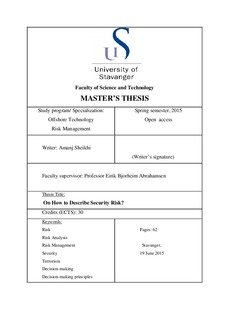| dc.description.abstract | The word terrorism is one of the most-used terms in a daily life of people in this century. Governments and organisations apply many different definitions to cope with their existing issue(s). Thus, the terrorism risk evaluation is one of the most important matters in today’s life. Many contributors involve in this process worldwide, and each organization or government has its preferences and definition. In Norway, several parties involve in the risk assessment investigation, i.e. (Egeli, 2014). Thus, using a standard procedure for the risk evaluation in this area is of interest. For this reason, the two Standard are considered (NS 5831, 2014, NS 5832, 2014).
The issue is to compare the existing scholarly literature within the area of security risk assessment with the standard procedure for security risk assessment in Norway to find the possible weakness points. The thesis discussed the most significant weakness points of the Standard and concluded that the four top points need reviewing and changing. The weakness points are risk definition, risk picture, strategies to deal with the risk, and applying the reducing measures.
At the end, the risk analysis may end up with the various alternative of different types each has its value and, therefore, the analysis compares them to each other to find the most suitable result. Standard suggests to find the threat from different contributors include technical, organizational, and human resources. The various contributors have different values, for example, the value of statistical life, damage to the infrastructure, and damage to the environment have not the same values and comparing them is a controversial task. According to Abrahamsen et al. (2011) the only way is to transform all attributes into the one comparable value. They stress that these frameworks are tools to help the decision-maker having the most useful and reliable decision and hence, the tools should take carefully to avoid the mechanical and decision-making process. Furthermore, the ALARP and the cautionary principle applies for both safety and security sector in the risk assessment to balance the situation safely and financially. The thesis focuses on the security standard in Norway, and suggest other Standards and Regulations for further work in this area. | nb_NO |

